

Clearer Thinking. Thou shalt not commit logical fallacies. Standards of Critical Thinking. What is critical thinking?
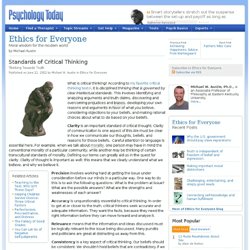
Fukushima’s doses tallied. YOSHIKAZU TSUNO/epa/Corbis Around 170 of Fukushima’s workers have a slightly elevated risk of cancer due to their radiation exposure.

Few people will develop cancer as a consequence of being exposed to the radioactive material that spewed from Japan’s Fukushima Daiichi nuclear power plant last year — and those who do will never know for sure what caused their disease. These conclusions are based on two comprehensive, independent assessments of the radiation doses received by Japanese citizens, as well as by the thousands of workers who battled to bring the shattered nuclear reactors under control. The first report, seen exclusively by Nature, was produced by a subcommittee of the United Nations Scientific Committee on the Effects of Atomic Radiation (UNSCEAR) in Vienna, and covers a wide swathe of issues related to all aspects of the accident. The UNSCEAR committee’s analyses show that 167 workers at the plant received radiation doses that slightly raise their risk of developing cancer.
Double X Science: Science, health, medical news freaking you out? Do the Double X Double-Take first. Red meat & mortality & the usual bad science. The media lit up on the evening of Monday March 12th as a press release was issued about an article in the Archives of Internal Medicine published that day.
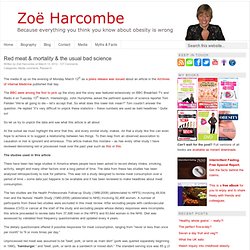
The BBC were among the first to pick up the story and the story was featured extensively on BBC Breakfast TV and Radio 4 on Tuesday 13th March. Interestingly, John Humphries asked the pertinent question of science reporter Tom Feilden “We’re all going to die – let’s accept that. RhetoricalFallacy_SameSexMarriage.png (1952×4178) Rhetological Fallacies. A brain-blending categorisation and visualisation of errors and manipulations of rhetoric and logical thinking.

How many do you use? The word ‘rhetological’ is made up. Informal Logic. First published Mon Nov 25, 1996; substantive revision Mon Nov 28, 2011 Informal logic is an attempt to develop a logic that can assess and analyze the arguments that occur in natural language (“everyday,” “ordinary language”) discourse.
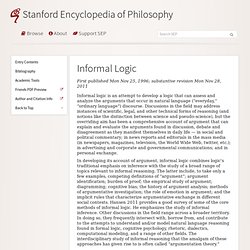
Discussions in the field may address instances of scientific, legal, and other technical forms of reasoning (and notions like the distinction between science and pseudo-science), but the overriding aim has been a comprehensive account of argument that can explain and evaluate the arguments found in discussion, debate and disagreement as they manifest themselves in daily life — in social and political commentary; in news reports and editorials in the mass media (in newspapers, magazines, television, the World Wide Web, twitter, etc.); in advertising and corporate and governmental communications; and in personal exchange.
Especially in its early formulations, informal logic was sometimes understood as a theoretical alternative to formal logic. 1. History. A Workbook For Arguments: A Complete Course In Critical Thinking - Books on Google Play. A Workbook for Arguments, A Complete Course in Critical Thinking - Google Books. Understanding Misunderstandings: How to do a rhetorical analysis. A Rulebook for Arguments. ENG 1001: Effective Arguments with Claims, Evidence, and Warrants. There are three major elements to persuasive writing and argumentation: claims, evidence, and warrants.

Each is explained below. Claims In a work of persuasive writing, the writer presents "claims," which are propositions that convey the writer's interpretations of or beliefs about something. Claims are not facts but rather conclusions that the writer draws from facts. The claims below convey interpretations of Henry David Thoreau's essay "Where I Lived, and What I Lived For," a selection from Thoreau's Walden. Notice how we could argue over the truth of the statements presented above. Argument. Www.dougwalton.ca/papers in pdf/10EmotRevista.pdf. Critical Thinking Worksite: Argument Evaluation. I.
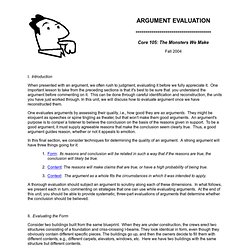
Introduction When presented with an argument, we often rush to judgment, evaluating it before we fully appreciate it. One important lesson to take from the preceding sections is that it's best to be sure that you understand the argument before commenting on it. This can be done through careful identification and reconstruction, the units you have just worked through. In this unit, we will discuss how to evaluate argument once we have reconstructed them. One evaluates arguments by assessing their quality, i.e., how good they are as arguments. In this final section, we consider techniques for determining the quality of an argument. Form: Its reasons and conclusion will be related in such a way that if the reasons are true, the conclusion will likely be true. A thorough evaluation should subject an argument to scrutiny along each of these dimensions.
II. Consider two buildings built from the same blueprint. The Logical Fallacies: Table of Contents. UCB Rhetoric - UCB Rhetoric Department Undergraduate Student Learning Goals. Straw Vulcan. Critical Thinking, the Series: Learning to ask “Why?” again. If intentional collaboration is the productive exchange of big ideas, then philosophy is an important foundation.
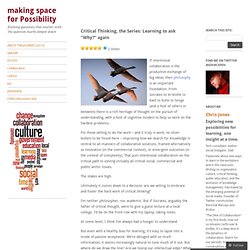
From Socrates to Aristotle to Kant to Kuhn to Senge (and a host of others in between) there is a rich heritage of thought on the pursuit of understanding, with a host of cognitive models to help us work on the hardest problems. For those willing to do the work – and it truly is work, no silver bullets to be found here – improving how we search for knowledge is central to all manners of collaborative solutions, framed alternatively as innovation (in the commercial context), or emergent outcomes (in the context of complexity). That puts intentional collaboration on the critical path to solving virtually all critical social, commercial and public sector issues. The stakes are high. Ultimately it comes down to a decision: are we willing to embrace and foster the hard work of critical thinking? I’m neither philosopher, nor academic. Start [Araucaria@ARG:dundee]
SMART 5 - Evaluating Sources. Evaluating Arguments Part One - Marianne Talbot. Evaluating arguments. Evaluating Logic and Validity. Many articles and essays are not written to present information clearly and directly; instead they may be written to persuade you to accept a particular viewpoint, to offer an, opinion, to argue for one side of a controversial issue.
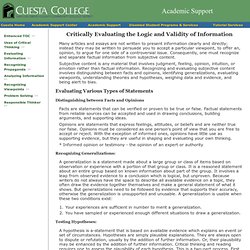
Consequently, one must recognize and separate factual information from subjective content. Subjective content is any material that involves judgment, feeling, opinion, intuition, or emotion rather than factual information. Recognizing and evaluating subjective content involves distinguishing between facts and opinions, identifying generalizations, evaluating viewpoints, understanding theories and hypotheses, weighing data and evidence, and being alert to bias. Evaluating Various Types of Statements Distinguishing between Facts and Opinions Facts are statements that can be verified or proven to be true or false. Opinions are statements that express feelings, attitudes, or beliefs and are neither true nor false.
Evaluating Arguments. Monty Python - Argument Clinic. The Nature of Arguments. Critical Thinking. In a model developed by Stephen Toulmin, arguments have three basic building blocks—claims, evidence and warrants. Claims are statements writers or speakers would like audiences (one or more people) to accept as true. Claims may be limited by qualifying statements (e.g., “Honesty is the best policy, most of the time.”) or by explanations of exceptions (e.g., “Honesty is the best policy, except when others’ feelings will be needlessly hurt.”). Often an argument will advance a main claim, which in turn may be supported by subclaims. Evidence consists of facts, statistics, examples, expert opinions, and previously established claims (including premises already accepted by the audience). Warrants provide reasoning that justifies the movement from evidence to claims.
The simplest arguments present only a main claim, which is directly backed with evidence: “George must be a vegetarian. More complex arguments present a main claim supported by subclaims. Analyzing the purpose of the argument. Critical Thinking Home Page. Critical thinking. Critical thinking is a type of clear, reasoned thinking.

According to Beyer (1995) Critical thinking means making clear, reasoned judgements. While in the process of critical thinking, ideas should be reasoned and well thought out/judged.[1] The National Council for Excellence in Critical Thinking defines critical thinking as the intellectually disciplined process of actively and skillfully conceptualizing, applying, analyzing, synthesizing, and/or evaluating information gathered from, or generated by, observation, experience, reflection, reasoning, or communication, as a guide to belief and action.'[2] Etymology[edit] Critical Thinking On The Web.
Top Ten Argument Mapping Tutorials. Six online tutorials in argument mapping, a core requirement for advanced critical thinking.The Skeptic's Dictionary - over 400 definitions and essays. The Fallacy Files by Gary Curtis. Best website on fallacies. Exploratree - Exploratree by FutureLab. Argument analysis. Rhetorical analysis views texts from within their particular situation.
In academic research, for example, the authors usually place their work in relation to relevant work that has preceded them. Any particular piece of written communication is part of a larger conversation with a history of its own. Writers and readers of this conversation share some common ground in their interests and assumptions. Argument Analysis: The Basic Method. Contact: Dr. Jan GarrettLast revised date: February 16, 2004Basic Terms Let's get clear on some basic terms regarding reasoning. Truth values: true, false. Fallacies. Dr. A List Of Fallacious Arguments.
Attacking the person instead of attacking his argument. Top 20 Logical Fallacies - The Skeptics' Guide to the Universe. Introduction to Argument. Atheism: Logic & Fallacies. Fallacious Argument. Carl Sagans Baloney Detection Kit. Start [Araucaria@ARG:dundee] Araucaria is a software tool for analysing arguments. How Theseus Works. Strategies for critical thinking in learning, Part I.
Thinking and recall series. Foundation for Critical Thinking: Books, Conferences and Academic Resources for Educators and Students. Elements and Standards Learning Tool. In this section, we offer an interactive model which details the analysis and assessment of reasoning, and enables you to apply the model to real life problems. Learn the Elements and Standards. Study of 38 Public Universities and 28 Private Universities To Determine Faculty Emphasis on Critical Thinking In Instruction. What is close reading? - a tutorial and guidance notes « Mantex. Mantex > Tutorials > 19C Literature > What is close reading? – guidance notes a brief guide to advanced reading skills. Close reading. Www.fas.harvard.edu/~wricntr/documents/CloseReading.html.
Two excellent examples of close-reading « Prizing the Postcolonial Weblog.